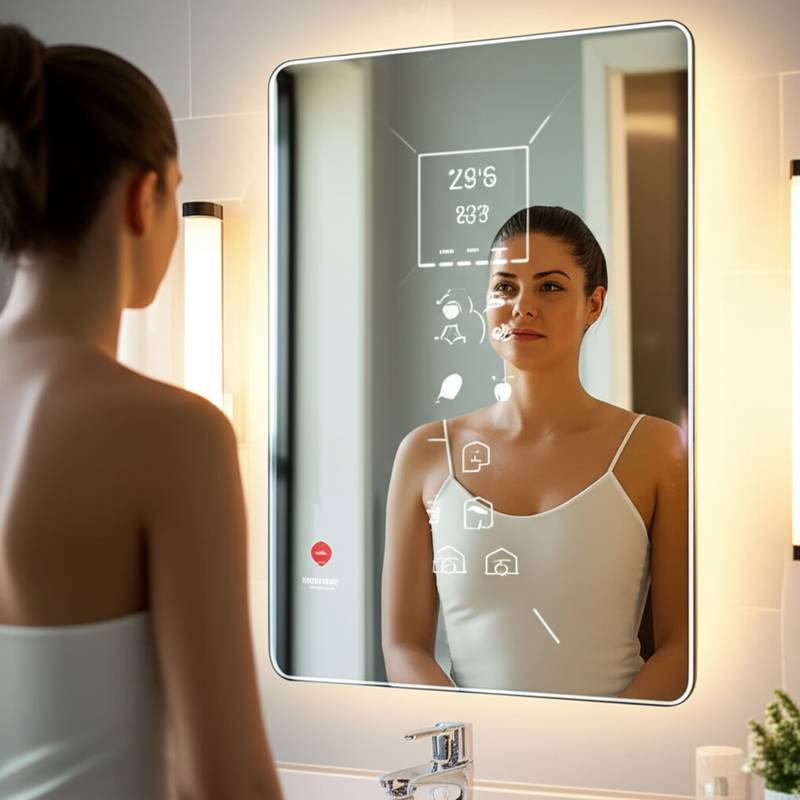Smart Mirrors Detect Health Issues Before Symptoms Appear
Smart Mirrors Enable Early Health Detection at Home
Mirrors have long served as quiet witnesses to daily routines. Today, smart mirrors actively contribute to health monitoring. These devices, once viewed as innovative curiosities, now function as diagnostic aids that identify subtle physiological shifts well before individuals recognize them.
Sensors, cameras, and advanced analytics power this capability. Users receive preventive health alerts integrated into routine activities. This development marks a significant advancement in home-based connected health solutions.
Picture a morning routine where the bathroom mirror evaluates heart rate, hydration status, or skin irregularities. Early notifications allow timely interventions without awaiting overt symptoms. Such technology redefines personal wellness by embedding diagnostics into familiar spaces.
Building Health-Focused Smart Homes
Smart homes extend beyond basic automation to prioritize well-being. Devices now track sleep patterns, indoor air quality, and movement levels. Smart mirrors integrate smoothly, converting standard fixtures into sources of individualized health data.
Market analyses indicate rising demand for preventive monitoring tools. Surveys show that many smart device owners already apply them to fitness and wellness goals. These mirrors advance this practice by providing ongoing, unobtrusive surveillance in private settings.
Users benefit from effortless operation. No charging or activation is required. Daily habits trigger automatic assessments, simplifying health oversight.
Technology Behind Smart Mirrors
Smart mirrors incorporate sensors, high-resolution cameras, and interactive displays. Near-infrared technology examines skin temperature and coloration. Facial recognition software identifies indicators of stress, exhaustion, or fluid imbalance.
Adaptive lighting ensures precise data capture. Microphones and speakers facilitate voice-guided responses. Connected applications synchronize information with mobile devices or authorized medical contacts.
The system establishes personal health baselines over time. It alerts to anomalies, such as eye-area swelling linked to inadequate rest or skin tone variations suggesting vascular concerns. This ongoing analysis supports informed daily decisions.
Benefits of Early Identification and Routine Integration
Early detection stands as the primary strength of smart mirrors. Numerous conditions progress without immediate signs, manifesting physically only in later stages. Prompt identification enables minor adjustments or professional consultations to avert escalation.
Consider these applications:
- Cardiovascular monitoring: Analysis of facial micro-movements from blood flow estimates heart rate and oxygenation.
- Dermatological assessment: Detection of emerging lesions, ultraviolet exposure effects, or patterns in dryness and blemishes.
- Mental and physical strain evaluation: Identification of facial muscle tightness or ocular fatigue to guide recovery strategies.
Established products deliver rapid hydration and pulse readings. Collaborations with skin specialists yield mirrors that monitor conditions and suggest tailored remedies. These innovations merge grooming practices with substantive health vigilance.
Shifting to Preventive Health Strategies
Conventional medicine typically intervenes post-symptom onset. Smart mirrors reverse this sequence by highlighting precursors. Users gain the tools for proactive choices, fostering sustained well-being.
Consistent tracking uncovers correlations in nutrition, rest, and tension levels. The device functions as an evolving health record, revealing trends invisible in isolation. Such visibility empowers effective habit modifications.
These mirrors enhance remote healthcare. Biometric logs transmitted to providers streamline virtual appointments. This linkage strengthens ongoing patient-provider relationships.
Safeguarding Privacy and Data Integrity
Connected devices raise valid security questions, particularly with biometric information. Leading producers implement end-to-end encryption, data anonymization, and consent-based sharing. Certain models process everything locally, minimizing external exposure.
Clear communication about data practices builds user confidence. Control options over information flow encourage adoption. Balancing functionality with protection determines market leaders in health tech.
Connecting to Comprehensive Wellness Networks
Smart mirrors collaborate with household systems for holistic insights. Detection of tiredness might adjust ambient lighting for relaxation. Hydration alerts could activate reminders from linked beverage containers.
Standardized communication protocols enable cross-brand compatibility. Mirrors serve as central hubs aggregating diverse metrics. This synergy boosts precision and user-friendliness, personalizing the living environment.
Advancing Diagnostics Through Artificial Intelligence
AI drives the interpretive power of smart mirrors. It evaluates imagery and sensor inputs against established health profiles to generate recommendations. Initial versions handled simple metrics; current iterations discern intricate cues like uneven facial features or dermal alterations tied to risks.
Learning algorithms adapt with user data, honing normalcy definitions. This customization heightens insight relevance. Partnerships with medical bodies verify algorithmic soundness, positioning mirrors as adjuncts to clinical expertise rather than substitutes.
Addressing Accessibility and Pricing
Early smart mirrors commanded premium prices due to novel components. Declining manufacturing costs now broaden availability. Modular add-ons permit enhancements to conventional mirrors without full replacements.
Commercial venues like gyms and resorts introduce the technology, allowing trial experiences. Projections forecast market expansion as passive monitoring gains appreciation. Widespread exposure accelerates household integration.
Building Trust in Emerging Tech
Novel devices often encounter doubt, especially regarding surveillance and precision. Concerns about constant observation or diagnostic reliability persist. Producers counter with forthright policies and expert validations.
Third-party evaluations and adherence to standards reinforce legitimacy. Mirrors position themselves as alert systems prompting professional follow-up, not standalone diagnosticians. This supportive stance eases acceptance.
Practical Applications in Daily Life
Explore these instances of impact:
- Routine vital checks: While preparing for the day, the mirror gauges pulse and moisture levels, proposing relaxation techniques if elevations appear.
- Ongoing skin evaluation: Daily scans track tonal and textural shifts, advising environmental tweaks after patterns emerge.
- Recovery prompts: Fatigue signals trigger sleep schedule adjustments, coordinating with home automation for optimal conditions.
- Trend analysis: Monthly reviews correlate lifestyle factors with metric variations, informing targeted improvements.
These examples illustrate integration into habits, promoting heightened self-awareness.
Expanding Horizons in Home Health Monitoring
Future enhancements will incorporate sensors for glucose estimation, hormonal fluctuations, or breathing analysis without intrusion. Cloud processing will deliver instantaneous overviews of physiological states.
Direct ties to services could automate supplement orders or appointment bookings. Preventive measures become instinctive components of life. Clinicians value applications in managing ongoing issues, such as daily cardiovascular surveillance to refine therapies and lessen crises.
Embracing Proactive Wellness Routines
Health-conscious environments redefine self-management. Smart mirrors facilitate transitions from response to anticipation. They infuse intelligence into customs, yielding effortless empowerment for lasting health gains.
